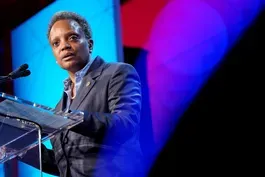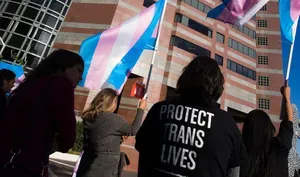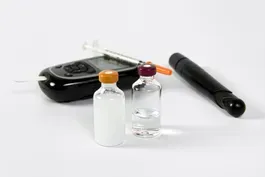
Climate change and the risk of spreading diseases
Clip: 3/1/2023 | 7m 37sVideo has Closed Captions
Is climate change accelerating the risk of disease spreading from animals to humans?
Scientists researching the aftermath of California wildfires say they are finding evidence that climate change is accelerating the risk of disease spreading from animals to humans. Science correspondent Miles O'Brien reports.
Problems with Closed Captions? Closed Captioning Feedback
Problems with Closed Captions? Closed Captioning Feedback
Major corporate funding for the PBS News Hour is provided by BDO, BNSF, Consumer Cellular, American Cruise Lines, and Raymond James. Funding for the PBS NewsHour Weekend is provided by...

Climate change and the risk of spreading diseases
Clip: 3/1/2023 | 7m 37sVideo has Closed Captions
Scientists researching the aftermath of California wildfires say they are finding evidence that climate change is accelerating the risk of disease spreading from animals to humans. Science correspondent Miles O'Brien reports.
Problems with Closed Captions? Closed Captioning Feedback
How to Watch PBS News Hour
PBS News Hour is available to stream on pbs.org and the free PBS App, available on iPhone, Apple TV, Android TV, Android smartphones, Amazon Fire TV, Amazon Fire Tablet, Roku, Samsung Smart TV, and Vizio.
Providing Support for PBS.org
Learn Moreabout PBS online sponsorshipAMNA NAWAZ: We spend a great deal of time looking at the impact of climate change and how it's changing our weather and environment.
That, in turn, can have an impact on how pathogens and disease could spread as well.
Our science correspondent, Miles O'Brien, has the story.
MILES O'BRIEN: Dawn in the High Sierra, 50 miles northwest of Reno at the Clover Valley Ranch.
BRIAN BIRD, One Health Institute, University of California, Davis: Remember to check every trap.
Walk the line.
MILES O'BRIEN: The hunt is on once again... BRIAN BIRD: Make sure you take the boxes, open, closed.
They're empty if there's no animal in it.
MILES O'BRIEN: ... for clues linking a changing climate and the worsening spread of disease.
That is ranch owner Brian Bird, a veterinarian, virologist and director of the One Health Institute Laboratory at the University of California, Davis.
BRIAN BIRD: Good hunting.
MILES O'BRIEN: Overnight, 47 of their quarry took the peanut butter, oats and bacon bait.
Now it's time to retrieve the traps.
BRIAN BIRD: I believe that's the most we have ever captured here.
MILES O'BRIEN: And gather some data.
For three years now, he and his students have been systematically trapping deer mice that live here.
They're hoping to better understand hantavirus.
The rodents are the primary reservoir for this pathogen.
BRIAN BIRD: It doesn't cause any harm to the rodent at all.
They carry the virus throughout their life.
But then they shed this virus in their urine and their feces.
MILES O'BRIEN: When a human gets hantavirus, is that pretty serious?
BRIAN BIRD: It can be very serious.
There are hundreds of cases a year.
Of those, 20 to 30, maybe even 50 percent could be fatal.
So it's a relatively rare, but a high-consequence disease.
MILES O'BRIEN: Hantavirus pulmonary syndrome is a so-called zoonotic disease, meaning it is spread by pathogens that spill over from one species to another.
This is the primary cause of pandemics throughout human history.
Human encroachment and global travel hasten these spillover events.
And it appears the climate crisis is making matters even worse.
BRIAN BIRD: So, as the animals get more and more stressed, they're more likely to shed a particular virus or a pathogen.
There's also the impact on the animals themselves.
So where do they live?
As those environments change, well, those animals will move.
They're adaptable at a species level, certainly.
But those changes occur very gradually, over perhaps millennia.
But now we're looking at rather dramatic, fast-paced changes on the time scale of hundreds of years, if not even faster.
MILES O'BRIEN: In September of 2021, he learned just how fast.
So did the fire come through here?
BRIAN BIRD: It did.
So you're working on burned area here.
MILES O'BRIEN: It was the Dixie megafire amplified by a historic drought linked to climate change.
It burned nearly a million acres over three months.
So you had been working in this spot prior to the fire?
BRIAN BIRD: Yes, exactly in this spot prior to the fire.
MILES O'BRIEN: Yes.
Wow.
BRIAN BIRD: And we had two seasons of sampling data here before the fire .
MILES O'BRIEN: Bird expected it would take years, even decades, to connect the dots.
But in his blackened field, he saw opportunity.
BRIAN BIRD: So, we thought, well, this would be a great time to continue that sampling and then see, well, how do the rodent populations respond to pretty much a complete destruction of their habitat?
MILES O'BRIEN: They're now finding active hantavirus in 8 percent of mice they're trapping.
In the unburned control site, it is 4 percent.
Bird says the mice are fighting to establish turf.
BRIAN BIRD: The primary method of transmitting the virus amongst the rodents is when they fight and bite each other.
So they could be transmitting the virus at a heightened rate, compared to a control site that wasn't burned.
MILES O'BRIEN: They're carving out turf and fighting, and that means more transmission, potentially.
BRIAN BIRD: Potentially, yes.
MILES O'BRIEN: So, climate change worsens a drought that triggers a megafire, which wipes out a habitat, causing a rodent rumble, a virus super-spreader, a nuanced link, to be sure, but not new.
The historical evidence linking the climate to zoonotic disease is growing.
Biologist Camilo Mora is a professor at the University of Hawaii at Manoa.
He led a team that pored through no less than 70,000 scientific studies dating back to the end of the Roman Empire.
CAMILO MORA, University of Hawaii at Manoa: Over 58 percent of those pathogens that have impacted humanity anywhere in the world are already affected by climatic changes.
But those are the ones that we already know.
The scary things are the ones that we just don't know about, because the ones that we know of, we know that we cannot cope with them.
You can imagine the surprise that we might get when we start unleashing all of these pathogens that could be more damaging to us.
MILES O'BRIEN: At Georgetown University, global change biologist Colin Carlson is working on a way to take the surprise out of this.
So, Colin, what are we looking at here?
COLIN CARLSON, Georgetown University: We are looking at the pathogen harmonized surveillance system.
MILES O'BRIEN: He is trying to meld existing climate and disease data in a way that allows epidemiologists to see the big picture.
COLIN CARLSON: So let's go to Berlin.
So, each of these points is somewhere that they have tested a fox for distemper virus.
What if we knew this much about viruses everywhere in the world?
What if we knew this about the diseases that we were worried about jumping into humans, right?
We can literally know within a city where spillover risk is the highest.
MILES O'BRIEN: He's building an open-source tool to forecast an outbreak sooner.
He foresees the ability to predict disease, as well as the weather.
COLIN CARLSON: If we want to get really good at predicting spillover, we need to know what the dynamics of these viruses are when we're not watching them.
MILES O'BRIEN: So can technology make it easier for public health professionals to monitor disease in wild animal populations?
Epidemiologist Christine Johnson is also a professor at the U.C.
Davis one health institute.
She is testing new ways to monitor one of the most prolific spreaders of zoonotic disease, bats.
CHRISTINE JOHNSON, One Health Institute, University of California, Davis: Well done, Jana (ph), yes.
Did you get that stream?
WOMAN: We did, yes.
(CROSSTALK) WOMAN: We got two of them.
MILES O'BRIEN: She and her team are testing thermal cameras, as well as audio devices able to record what bat echolocation sounds like.
They hope to deploy the technology to make their work more efficient and safer.
CHRISTINE JOHNSON: We don't like to go into bat caves for so many reasons, especially because they're very dark.
We're able to see them much more clearly with thermal cameras than we could just see with our own eyes.
The techniques that we're developing could be used to do that remotely.
MILES O'BRIEN: She is collaborating with the engineering department, seeking ways to monitor and test bat populations remotely.
CHRISTINE JOHNSON: And so that's what we're seeking is, with the innovative technology that we're using to try to bring much more feasibility to wildlife surveillance.
MILES O'BRIEN: There are more and more zoonotic diseases coming.
The climate crisis makes it unavoidable.
A greater investment to protect public health with some 21st century tools, along with the risky, laborious field work, might be the only way to stop a spillover from boiling over, shutting down the world once again.
For the "PBS NewsHour," I'm Miles O'Brien, near Portola, California.
Arizona Republican turns to art after political career ends
Video has Closed Captions
Clip: 3/1/2023 | 3m 28s | Republican who opposed 2020 election lies finds time for art after political career ends (3m 28s)
News Wrap: Chicago voters oust mayor with crime a top issue
Video has Closed Captions
Clip: 3/1/2023 | 5m 55s | News Wrap: Chicago voters oust mayor in election where crime was a top issue (5m 55s)
Parents concerned as new laws target transgender children
Video has Closed Captions
Clip: 3/1/2023 | 11m 3s | Parents concerned as new state laws restrict rights of transgender children (11m 3s)
Pharmaceutical giant slashes insulin prices after pressure
Video has Closed Captions
Clip: 3/1/2023 | 5m 12s | Pharmaceutical giant slashes insulin prices after pressure from government and consumers (5m 12s)
Ruling party candidate wins Nigeria's presidency
Video has Closed Captions
Clip: 3/1/2023 | 5m 23s | Ruling party candidate wins Nigeria's presidency after disputed vote (5m 23s)
'Very unlikely' adversary caused Havana Syndrome, U.S. says
Video has Closed Captions
Clip: 3/1/2023 | 6m 20s | 'Very unlikely' foreign adversary caused Havana Syndrome, U.S. intelligence says (6m 20s)
Providing Support for PBS.org
Learn Moreabout PBS online sponsorshipSupport for PBS provided by:
Major corporate funding for the PBS News Hour is provided by BDO, BNSF, Consumer Cellular, American Cruise Lines, and Raymond James. Funding for the PBS NewsHour Weekend is provided by...
















